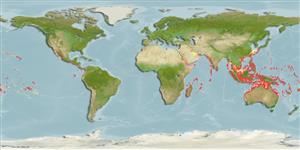>
Lophiiformes (Anglerfishes) >
Antennariidae (Frogfishes)
Etymology: Antennarius: From Latin, antenna, antemna = sensory organ (Ref. 45335).
Eponymy: Dr Philibert Commerson (1727–1773) was known as ‘doctor, botanist and naturalist of the King’. [...] (Ref. 128868), visit book page.
More on author: Lacepède.
Environment: milieu / climate zone / пределы глубины / distribution range
экология
морской ассоциированный с рифами; пределы глубины 0 - 70 m (Ref. 89972), usually ? - 20 m (Ref. 9269). Tropical; 32°N - 32°S
Indo-Pacific and Eastern Pacific: Red Sea and South Africa (Ref. 4113) to Panama, north to southern Japan and the Hawaiian Islands, south to the Lord Howe and the Society islands. Referred to as Antennarius moluccensis by authors.
Size / Вес / Возраст
половая зрелость: Lm ? range ? - ? cm
Max length : 45.0 cm TL самец/пол неопределен; (Ref. 90102)
Краткое описание
определительные ключи | морфология | морфометрия
колючие лучи спинного плавника (общее число) : 3; членистые (мягкие) лучи спинного плавника (общее число) : 12 - 13; колючие лучи анального плавника: 0; членистые (мягкие) лучи анального плавника: 8. Comes in a variety of colors: yellow, orange, green, brown, and black. Bony part of illicium about equal to length of the 2nd dorsal spine (10.2-16.9 %SL); esca a small tuft of flattened appendages (Ref. 4538). Illicial length in %SL: 19.3-25.2 (Ref. 6773). Membrane behind 2nd dorsal spine thick and spinulose, extending to base of third (Ref. 6773). One of the largest species (Ref. 48635).
Body shape (shape guide): short and / or deep; Cross section: compressed.
Found in lagoon and seaward reefs (Ref. 9710), often on jetty (Ref. 48635). Benthic (Ref. 58302). Feed on fish (Ref. 11889) and small shrimps (Ref. 89972). Oviparous. Eggs are bound in ribbon-like sheath or mass of gelatinous mucus called 'egg raft' or 'veil' (Ref. 6773). Solitary and frequently among sponges in 1-50 m, usually less than 20 m (Ref 90102).
Life cycle and mating behavior
половая зрелость | размножение | нерест | икра | Fecundity | личинки
Oviparous. Eggs are bound in ribbon-like sheath or mass of gelatinous mucus called 'egg raft' or 'veil' (Ref. 6773).
Pietsch, T.W. and D.B. Grobecker, 1987. Frogfishes of the world. Systematics, zoogeography, and behavioral ecology. Stanford University Press, Stanford, California. 420 p. (Ref. 6773)
Статус Красного Списка МСОП (Ref. 130435: Version 2025-1)
Угроза для людей
Harmless
Использование человеком
рыболовство: интереса не представляет
дополнительная информация
инструменты
Специальные отчеты
Скачать в формате XML
ресурсы в Интернет
Estimates based on models
Preferred temperature (ссылка
123201): 24.5 - 29, mean 27.9 °C (based on 652 cells).
Phylogenetic diversity index (ссылка
82804): PD
50 = 0.5002 [Uniqueness, from 0.5 = low to 2.0 = high].
Bayesian length-weight: a=0.02630 (0.01029 - 0.06725), b=2.96 (2.73 - 3.19), in cm total length, based on LWR estimates for this (Sub)family-body shape (Ref.
93245).
Trophic level (ссылка
69278): 4.2 ±0.73 se; based on food items.
устойчивость к внешним воздействиям (ссылка
120179): высокий, минимальное время удвоения популяции до 15 месяцев (Fec assumed to be > 10,000).
Fishing Vulnerability (Ref.
59153): Low to moderate vulnerability (35 of 100).
🛈
Nutrients (Ref.
124155): Calcium = 35.3 [17.9, 59.7] mg/100g; Iron = 0.568 [0.304, 0.993] mg/100g; Protein = 19 [17, 22] %; Omega3 = 0.105 [0.040, 0.254] g/100g; Selenium = 34.5 [16.4, 78.0] μg/100g; VitaminA = 101 [26, 373] μg/100g; Zinc = 0.82 [0.53, 1.24] mg/100g (wet weight);
